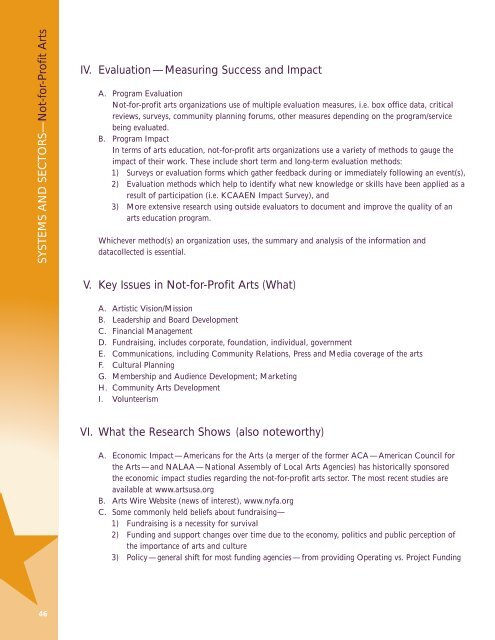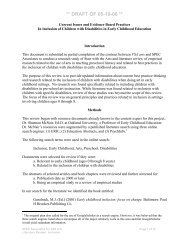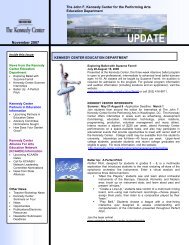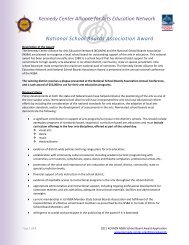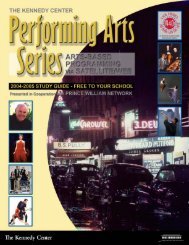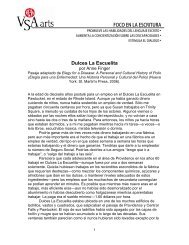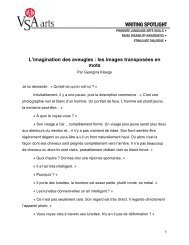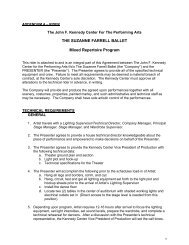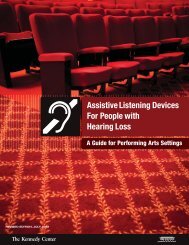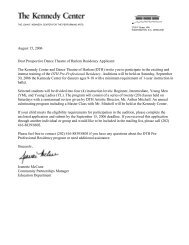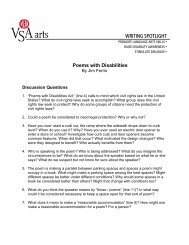KCAAEN Leadership Kit - The John F. Kennedy Center for the ...
KCAAEN Leadership Kit - The John F. Kennedy Center for the ...
KCAAEN Leadership Kit - The John F. Kennedy Center for the ...
Create successful ePaper yourself
Turn your PDF publications into a flip-book with our unique Google optimized e-Paper software.
SYSTEMS AND SECTORS—Not-<strong>for</strong>-Profit Arts<br />
IV. Evaluation—Measuring Success and Impact<br />
A. Program Evaluation<br />
Not-<strong>for</strong>-profit arts organizations use of multiple evaluation measures, i.e. box office data, critical<br />
reviews, surveys, community planning <strong>for</strong>ums, o<strong>the</strong>r measures depending on <strong>the</strong> program/service<br />
being evaluated.<br />
B. Program Impact<br />
In terms of arts education, not-<strong>for</strong>-profit arts organizations use a variety of methods to gauge <strong>the</strong><br />
impact of <strong>the</strong>ir work. <strong>The</strong>se include short term and long-term evaluation methods:<br />
1) Surveys or evaluation <strong>for</strong>ms which ga<strong>the</strong>r feedback during or immediately following an event(s),<br />
2) Evaluation methods which help to identify what new knowledge or skills have been applied as a<br />
result of participation (i.e. <strong>KCAAEN</strong> Impact Survey), and<br />
3) More extensive research using outside evaluators to document and improve <strong>the</strong> quality of an<br />
arts education program.<br />
Whichever method(s) an organization uses, <strong>the</strong> summary and analysis of <strong>the</strong> in<strong>for</strong>mation and<br />
datacollected is essential.<br />
V. Key Issues in Not-<strong>for</strong>-Profit Arts (What)<br />
A. Artistic Vision/Mission<br />
B. <strong>Leadership</strong> and Board Development<br />
C. Financial Management<br />
D. Fundraising, includes corporate, foundation, individual, government<br />
E. Communications, including Community Relations, Press and Media coverage of <strong>the</strong> arts<br />
F. Cultural Planning<br />
G. Membership and Audience Development; Marketing<br />
H. Community Arts Development<br />
I. Volunteerism<br />
VI. What <strong>the</strong> Research Shows (also noteworthy)<br />
A. Economic Impact—Americans <strong>for</strong> <strong>the</strong> Arts (a merger of <strong>the</strong> <strong>for</strong>mer ACA—American Council <strong>for</strong><br />
<strong>the</strong> Arts—and NALAA—National Assembly of Local Arts Agencies) has historically sponsored<br />
<strong>the</strong> economic impact studies regarding <strong>the</strong> not-<strong>for</strong>-profit arts sector. <strong>The</strong> most recent studies are<br />
available at www.artsusa.org<br />
B. Arts Wire Website (news of interest), www.nyfa.org<br />
C. Some commonly held beliefs about fundraising—<br />
1) Fundraising is a necessity <strong>for</strong> survival<br />
2) Funding and support changes over time due to <strong>the</strong> economy, politics and public perception of<br />
<strong>the</strong> importance of arts and culture<br />
3) Policy—general shift <strong>for</strong> most funding agencies— from providing Operating vs. Project Funding<br />
46


